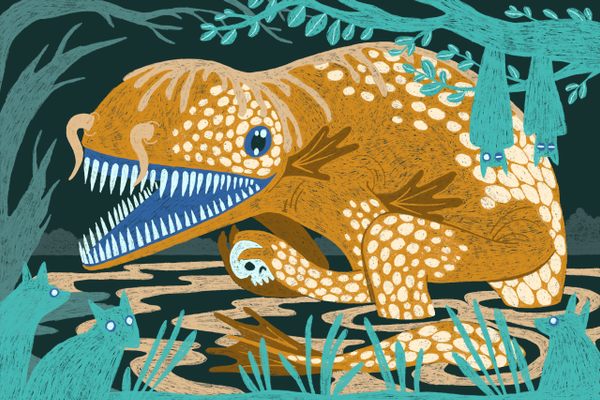In North Dakota, the Hideous Miniwashitu Ushers in Spring
The Madan people knew the Missouri River could bring both salvation and destruction.
Winter in North Dakota is a monster. In Bismarck, the state capital, the first frost can arrive in September and below-freezing temperatures can stretch into May. By December, ice coats the width of the Missouri River, sometimes in a sheet as thick as six feet, and the icy mass can block passage along the waterway near Bismarck for three months or more.
But spring in North Dakota can be a monster, too. Among the Indigenous Madan people, it was a fearsome beast with a face and a name: the Miniwashitu.
The Mandan people likely settled along the banks of the Missouri River and its tributaries, including the Heart River just to the south of modern-day Bismarck and Knife River, 50 miles to the north, sometime between 1100 and 1300. By the time white fur traders arrived centuries later, the Mandan and other Indigenous communities that made their home there had already turned this stretch of the Missouri River into a thriving hub for trade. The river and the goods that passed along it were vital for the agricultural Mandan people, so the winter months must have been a trial. Warmer weather and the groaning ice should have been a sign of salvation, but before the river could begin to run again, the mį́nį (water) monster had to appear.

As an informant told ethnologist Melvin Randolph Gilmore in the early years of the 20th century, Miniwashitu was a “dreadful being.” It was “covered all over with hair like a buffalo, but red in color…it had only one eye in the middle of its forehead, and above that a single horn. Its backbone stood out notched and jagged like an enormous saw,” he wrote.
Its arrival was announced by “a terrific roaring sound,” as Miniwashitu swam up the Missouri River, using its enormous body and lethal backbone to break up the ice. To see the monster at night was to witness a red streak as bright as a flame in the middle of the icy waterway. But to see it by day was a death sentence.
Gilmore was told that “not a great many years ago,” one man spotted the creature. He lived only long enough to describe the sight and its consequences. The world went dark, and then he “lost his reason.” Soon after, he died.
By the time Gilmore heard the tale, the dangers of the river were no longer mythical for the Mandan. The traders who had followed its route brought smallpox with them; an outbreak in 1782 and again in 1837 had decimated the tribe.
Though many Mandan traditions have since been lost, legends of Miniwashitu still live along the Missouri River and its North Dakota tributaries. But he is not so frightening now: A recent description by KXNews, western North Dakota’s CBS affiliate, insists that the “bipedal buffalo” is a pescatarian, subsisting on plants, fish, and grass. And though cryptid aficionados have likened the creature to a cross between West Virginia’s aggressive, saber-toothed sheepsquatch and the Southwest’s blood-sucking chupacabra, most modern renderings of Miniwashitu show it as an amiable, cycloptic unicorn. But if you hear “a terrific roar” along the Missouri River during the day, just remember to look away and let the hard-working water monster usher in spring.














Follow us on Twitter to get the latest on the world's hidden wonders.
Like us on Facebook to get the latest on the world's hidden wonders.
Follow us on Twitter Like us on Facebook